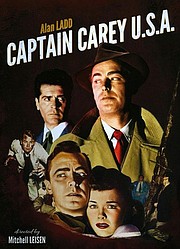Captain Carey, U.S.A. (1950)
Next year marks the 70th anniversary of the mystery thriller Captain Carey, U.S.A. (But it was shot in 1949, so we are OK timewise, more or less.)
But more important than the film's anniversary release is that this film introduced the evergreen "Mona Lisa," which was written by Jay Livingston and Ray Evans. More on that later.
Captain Carey, U.S.A. concerns two OSS agents sent to Italy during WWII to undermine the Nazis. While hiding in the basement of the palace of Countess de Cresci (Celia Lovsky), the countess' granddaughter Julie (Wanda Hendrix) and Carey (Alan Ladd) discover a hidden room filled with artworks. One painting in particular strikes Julie's fancy, which Carey dismisses as awful. The two have become enamored of each other and plan to wed after the war.
But someone has tipped off the Nazis that two Americans are hiding in the palace. They storm the place; Carey is injured and partner Frank (Paul Lees) is killed along with 27 townsmen in the process -- due to the informant's betrayal.
Four years later, after several years' convalescence, Carey discovers the same "awful" painting -- with a huge price tag -- in a New York art gallery. (Only he, Frank and Julie knew about the secret room, and whoever sold the painting to the art dealer is also the traitor.) He returns to Italy to track down the person who caused the deaths of his partner and the townsmen. He is met with suspicion and disdain as many villagers blame him for the deaths.
The film turns into a Hitchcockian mystery of intrigue as Carey's "informed sources" start to drop like flies.
Back to "Mona Lisa": the song was used as a warning to the underground that the Nazis were approaching. So, every time you hear that wonderful tune (on a guitar, accordion or sung in Italian) you know to beware -- the bad guys are coming.
Thank God for Nat "King" Cole and his rendition, which became a huge hit for him and anyone else who recorded it. In 1950 alone, artists included Victor Young with Don Cherry, Harry James with Dick Williams, Art Lund, Charlie Spivak with Tommy Lynn, and Dennis Day. And it won (deservedly so) the Academy Award for best original song for 1950.
The film is mostly forgotten in the Ladd filmography, as he was usually cast as a heavy in his earlier films: This Gun for Hire, The Glass Key, Lucky Jordan, The Blue Dahlia. But it deserves rediscovery on this auspicious occasion.
The rest of the cast: Hendrix, so memorable as the tragic Else in Confidential Agent, was married to Audie Murphy for about 15 minutes; Francis Lederer (Baron de Greffi), was an actor who became a wealthy real-estate investor later in life and lived to be 100; Joseph Calleia (Dr. Lunati), played lots of good guys and bad guys; and Lovsky, married to Peter Lorre, was a prolific character actress whose career started after she divorced Lorre.
The film was directed by Mitchell Leisen, who made several superior films for Paramount including The Mating Season, No Man of Her Own, To Each His Own, Lady in the Dark and Hold Back the Dawn.
MovieStyle on 10/11/2019
